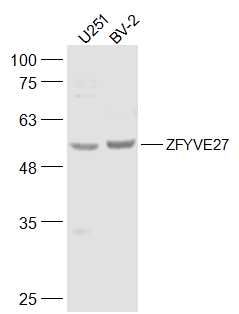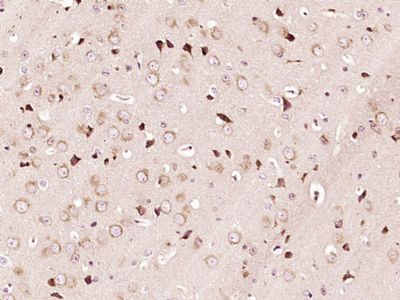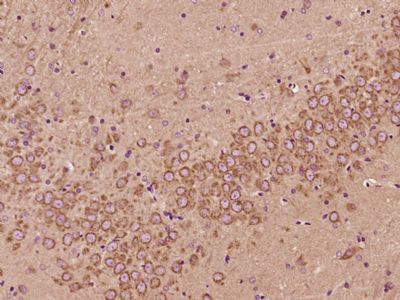Zinc finger FYVE domain-containing protein 27 (ZFYVE27), also known as SPG33, is a 411 amino acid member of the FYVE-finger family of proteins. The FYVE domain is a cysteine-rich domain of about 70 amino acids that plays a role in the endosomal localization of the FYVE-finger proteins, and a majority of these proteins serve as regulators of endocytic membrane trafficking. ZFYVE27, a multi-pass membrane protein, is an endosomal protein that binds to Spastin, a protein that is primarily involved in microtubule dynamics and severing, vesicular trafficking and endosomal trafficking. Mutations in the gene encoding ZFTVE27 affect neuronal intracellular trafficking in the corticospinal tract and are thought to lead to hereditary spastic paraplegia (HSP), a neurodegenerative disorder, characterized by progressive paralysis of the legs, which is caused by impaired axonal transport. Five isoforms of ZFYVE27 exist as a result of alternative splicing events.
Function:
Functions as an upstream inhibitor of RAB11, regulating directional protein transport to the forming neurites. Involved in nerve growth factor-induced neurite formation. May have a more general role in cell projections formation.
Subcellular Location:
Recycling endosome membrane. Endoplasmic reticulum membrane. Cell projection > growth cone membrane. Cell membrane. Localizes at both dendrites and axons.
Post-translational modifications:
Phosphorylated. Phosphorylation is induced by NGF through the MAPK/ERK pathway and modulates interaction with RAB11A.
DISEASE:
Defects in ZFYVE27 are the cause of spastic paraplegia autosomal dominant type 33 (SPG33) [MIM:610244]. Spastic paraplegia is a neurodegenerative disorder characterized by a slow, gradual, progressive weakness and spasticity of the lower limbs. Rate of progression and the severity of symptoms are quite variable. Initial symptoms may include difficulty with balance, weakness and stiffness in the legs, muscle spasms, and dragging the toes when walking. In some forms of the disorder, bladder symptoms (such as incontinence) may appear, or the weakness and stiffness may spread to other parts of the body. Note=According to PubMed:18606302, the properties of the variant Val-191 and its frequency in some populations raise doubts on the implication of that gene in the disease.
Similarity:
Contains 1 FYVE-type zinc finger.
SWISS:
Q5T4F4
Gene ID:
118813
Database links:
Entrez Gene: 486825 Dog
Entrez Gene: 118813 Human
Entrez Gene: 319740 Mouse
Entrez Gene: 309376 Rat
Omim: 610243 Human
SwissProt: Q5T4F4 Human
SwissProt: Q3TXX3 Mouse
SwissProt: Q6P7B7 Rat
Unigene: 523194 Human
Unigene: 287359 Mouse
Unigene: 470071 Mouse
Unigene: 99939 Rat
| Picture |
Sample:
U251(Human) Cell Lysate at 30 ug
BSLV2(Mouse) Cell Lysate at 30 ug
Primary: Anti-ZFYVE27 (SL11777R) at 1/500 dilution
Secondary: IRDye800CW Goat Anti-Rabbit IgG at 1/20000 dilution
Predicted band size: 46 kD
Observed band size: 51 kD
Paraformaldehyde-fixed, paraffin embedded (Mouse brain); Antigen retrieval by boiling in sodium citrate buffer (pH6.0) for 15min; Block endogenous peroxidase by 3% hydrogen peroxide for 20 minutes; Blocking buffer (normal goat serum) at 37°C for 30min; Antibody incubation with (ZFYVE27) Polyclonal Antibody, Unconjugated (SL11777R) at 1:400 overnight at 4°C, followed by operating according to SP Kit(Rabbit) (sp-0023) instructionsand DAB staining.
Paraformaldehyde-fixed, paraffin embedded (Rat brain); Antigen retrieval by boiling in sodium citrate buffer (pH6.0) for 15min; Block endogenous peroxidase by 3% hydrogen peroxide for 20 minutes; Blocking buffer (normal goat serum) at 37°C for 30min; Antibody incubation with (ZFYVE27) Polyclonal Antibody, Unconjugated (SL11777R) at 1:400 overnight at 4°C, followed by operating according to SP Kit(Rabbit) (sp-0023) instructionsand DAB staining.
|
|
|


